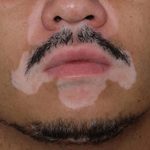 A chronic skin disease that causes loss of pigment, resulting in irregular pale patches of skin. It occurs when the melanocytes, cells responsible for skin pigmentation, die or are unable to function. Also called leucoderma.
A chronic skin disease that causes loss of pigment, resulting in irregular pale patches of skin. It occurs when the melanocytes, cells responsible for skin pigmentation, die or are unable to function. Also called leucoderma.
A condition in which destruction of melanocytes in small or large circumscribed areas results in patches of depigmentation often having a hyperpigmented border, and often enlarging slowly.
A skin disease characterized by whitish nonpigmented areas surrounded by hyperpigmented borders.
An abnormality of the skin characterized by a loss of pigment, producing white patches surrounded by pigmented borders, leukoderma.
A condition in which white patches appear on the skin.
A skin disorder in which patches of skin are white and colorless because of lack of skin cells called melanocytes, which produce the dark pigment melanin. (Another disorder, albinism, results from melanocytes that are present but not functioning properly.) Of unknown origin, vitiligo may appear at any age, though usually in early adulthood. Some suggest that it is an autoimmune disorder, while others think that at least some forms are genetic disorders. It is sometimes associated with Addison’s disease, diabetes mellitus, pernicious anemia, and thyroid gland disorders. People with vitiligo are especially susceptible to sunburn. Sometimes pigment reappears in at least some portions of the affected skin. Among the treatments used for vitiligo is PUVA, a form of phototherapy combined with medications.
Acquired, benign skin disease characterized by irregular patches of unpigmented skin, often surrounded by a hyperpigmented border, occurring most often on exposed areas of the skin. The cause is unknown, and there is no satisfactory treatment.
Skin disease characterized by patches without pigmentation.
A skin disorder characterized by patches of white skin resulting from loss of pigment cells (melanocytes). Although its exact cause is unknown, vitiligo is believed to have an autoimmune component in which the immune system mistakes the melanocytes for invading microorganisms and destroys them. Although most people with vitiligo are generally in good health, they are at increased risk of developing thyroid dysfunction, vitamin B12 deficiency, diabetes, and alopecia areata (a temporary loss of patches of hair). There is no cure for vitiligo, but treatments are available.
A condition in which areas of skin lose their pigment and become white. There are no other changes, but the white patches, which appear anywhere, grow in size until much of the body is affected. The cause is unknown and there is no satisfactory treatment.
A disease in which small or large areas of skin lose their pigment and become white because of a reduction in the body’s production of melanin. The hair may be similarly affected. Probably a consequence of an autoimmune mechanism, vitiligo is associated with other autoimmune diseases such as thyroiditis and Addison’s disease. There is no cure; the vitiliginous skin must be protected from sunburn and certain camouflage cosmetics are available (and pre-scribable on the NHS under certain conditions).
A skin disorder characterized by the localized loss of melanocytes, with patchy loss of skin pigment. The depigmented areas, which appear most commonly on the hands, face, and genital region, are flat and pale and surrounded by normal pigmentation. Vitiligo affects all ages and races but is most noticeable in people with dark skin. The cause is unknown, but may be an autoimmune process since autoantibodies to melanocytes have been identified and vitiligo often occurs with autoimmune diseases.
Hereditary condition that causes hypopigmented spots and splotches on the skin; may be related to thyroid conditions.
Vitiligo, a persistent skin condition, leads to depigmentation or loss of color in certain areas of the skin, commonly occurring on the face, hands, and wrists.
A prevalent condition affecting skin coloration, vitiligo results in the loss of pigment in certain skin areas, often observed on the face, hands, armpits, and groin. It’s believed to be an autoimmune condition where the body’s immune system targets its own tissues. While vitiligo can manifest at any age, it most commonly emerges during early adulthood.
In some instances, natural repigmentation of the skin takes place. Phototherapy sessions using PUVA can also encourage the skin to regain its color, and topical creams with corticosteroids may be beneficial.
Piebald skin is a condition characterized by the loss of natural pigmentation in certain areas, resulting in white patches on the skin. It is also known as leukoderma.
